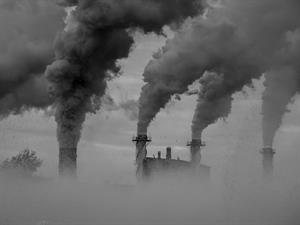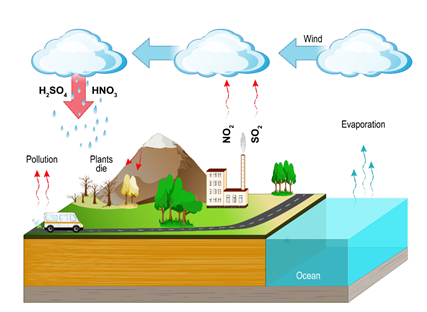PDF chapter test TRY NOW
We know that air has different uses and is essential for all living things. We contaminate the atmosphere through a variety of environmental contributions, such as modernization.

Air pollution is the change in air's chemical composition due to the presence of pollutants that can be hazardous to humans and the environment.
Various sources pollute the air, such as carbon dioxide, nitrogen oxide, sulphur oxide, lead, smoke, soot, carbon monoxide, ozone, etc. These sources of pollutants are from the emission of industrialisation, the combustion process, and so on.

All gases except ozone are absorbed into the atmosphere, which pollutes the air. These sources of pollution and their effects can lead to various issues regarding health and the environment.
1. Air Pollutants:
Carbon dioxide () - The emission of this gas is from the complete combustion process, vehicles and industries etc. This lend smog (smoke + fog) formation in the environment. The health risk includes an increase in heartbeat, vision problems, etc.
Nitrogen oxides () - This is released from industries, electricity generation, automobiles etc. Nitrogen oxides also lead to the formation of smog. This leads to heart, lung diseases and even problems with breathing.
Sulphur oxide () - This gas is also released from industries, automobiles, combustion of fossil fuels etc. Sulphur oxide lends acid rain and damages foliage(the leaves of a tree or plant). This pollutant also damages the buildings and monuments, causes skin problems, asthma, heart diseases, etc.
Lead () - This is released from metal processing, waste incineration, combustion of fossil fuels and so on. Lead has an adverse effect on the environment, causing the loss in biodiversity, neurological problems, decreased reproduction etc. This also harms humans, especially children's; when exposed, it causes a learning disability affecting s the neurological system.
Nitrogen oxides () - This is released from industries, electricity generation, automobiles etc. Nitrogen oxides also lead to the formation of smog. This leads to heart, lung diseases and even problems with breathing.
Sulphur oxide () - This gas is also released from industries, automobiles, combustion of fossil fuels etc. Sulphur oxide lends acid rain and damages foliage(the leaves of a tree or plant). This pollutant also damages the buildings and monuments, causes skin problems, asthma, heart diseases, etc.
Lead () - This is released from metal processing, waste incineration, combustion of fossil fuels and so on. Lead has an adverse effect on the environment, causing the loss in biodiversity, neurological problems, decreased reproduction etc. This also harms humans, especially children's; when exposed, it causes a learning disability affecting s the neurological system.
Ozone () - Ozone is released from nitrogen oxides, emission from industries, volatile organic compounds etc. Ozone interferes with plants' absorption patterns, which causes irritation and inflammation of breathing passages.
The pollutants mentioned above are released into the atmosphere at a very high rate except for lead.
2. Air Toxics:
Likewise, there are hundreds of compounds considered harmful, although they are present in minuscule concentrations in the air. These are called air toxins. The hazardous air pollutants are arsenic, asbestos, benzene, beryllium, coke oven emissions, cyanide, mercury compounds, radon, radium, uranium, vinyl chloride etc.
The sources of air toxics are from weathering of rocks (arsenic), natural deposits (asbestos), vehicle exhaust (benzene), papermaking (chlorine), automobile exhaust (cyanide), uranium mines(uranium) sewage sludge incineration (nickel compounds), battery manufacturing (lead compounds), etc.
These air toxics may be released in sudden and catastrophic accidents. For example, the Bhopal disaster of 1984 releasedmethyl isocyanate. This air toxic immediately killed 3,000 people and eventually took the life around 15,000 to 25,000 people after the incident. Hazardous air pollutants may be released when equipment leaks or when the material is transferred, or they may be emitted from smokestacks.
The sources of air toxics are from weathering of rocks (arsenic), natural deposits (asbestos), vehicle exhaust (benzene), papermaking (chlorine), automobile exhaust (cyanide), uranium mines(uranium) sewage sludge incineration (nickel compounds), battery manufacturing (lead compounds), etc.
These air toxics may be released in sudden and catastrophic accidents. For example, the Bhopal disaster of 1984 releasedmethyl isocyanate. This air toxic immediately killed 3,000 people and eventually took the life around 15,000 to 25,000 people after the incident. Hazardous air pollutants may be released when equipment leaks or when the material is transferred, or they may be emitted from smokestacks.
The toxic air pollution levels are generic in large cities, where particulates and gases from transportation, heating, and manufacturing accumulate and linger in the atmosphere.
